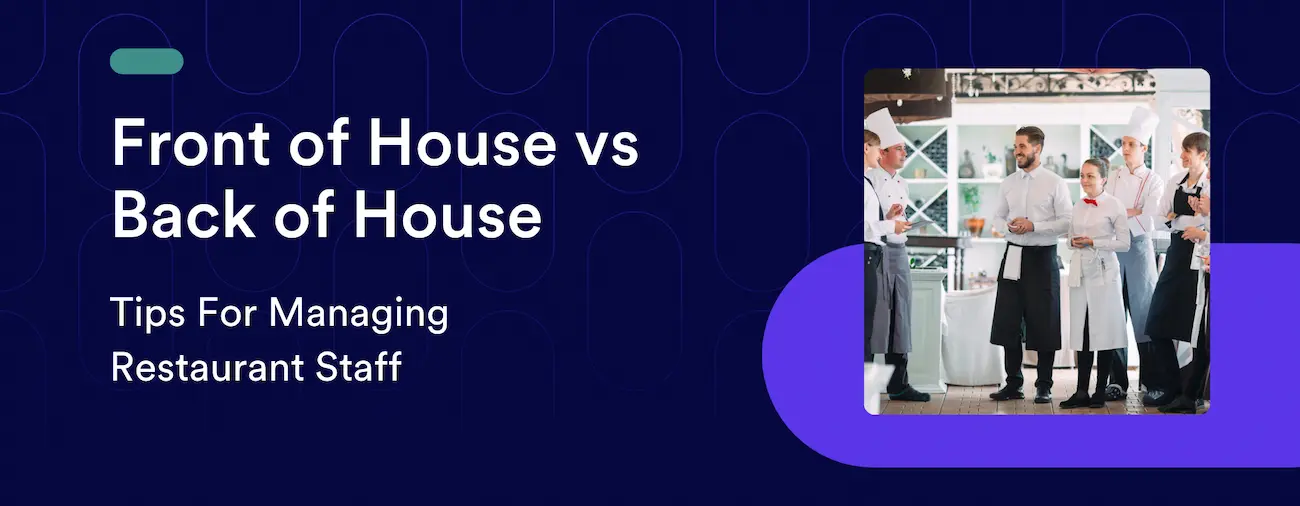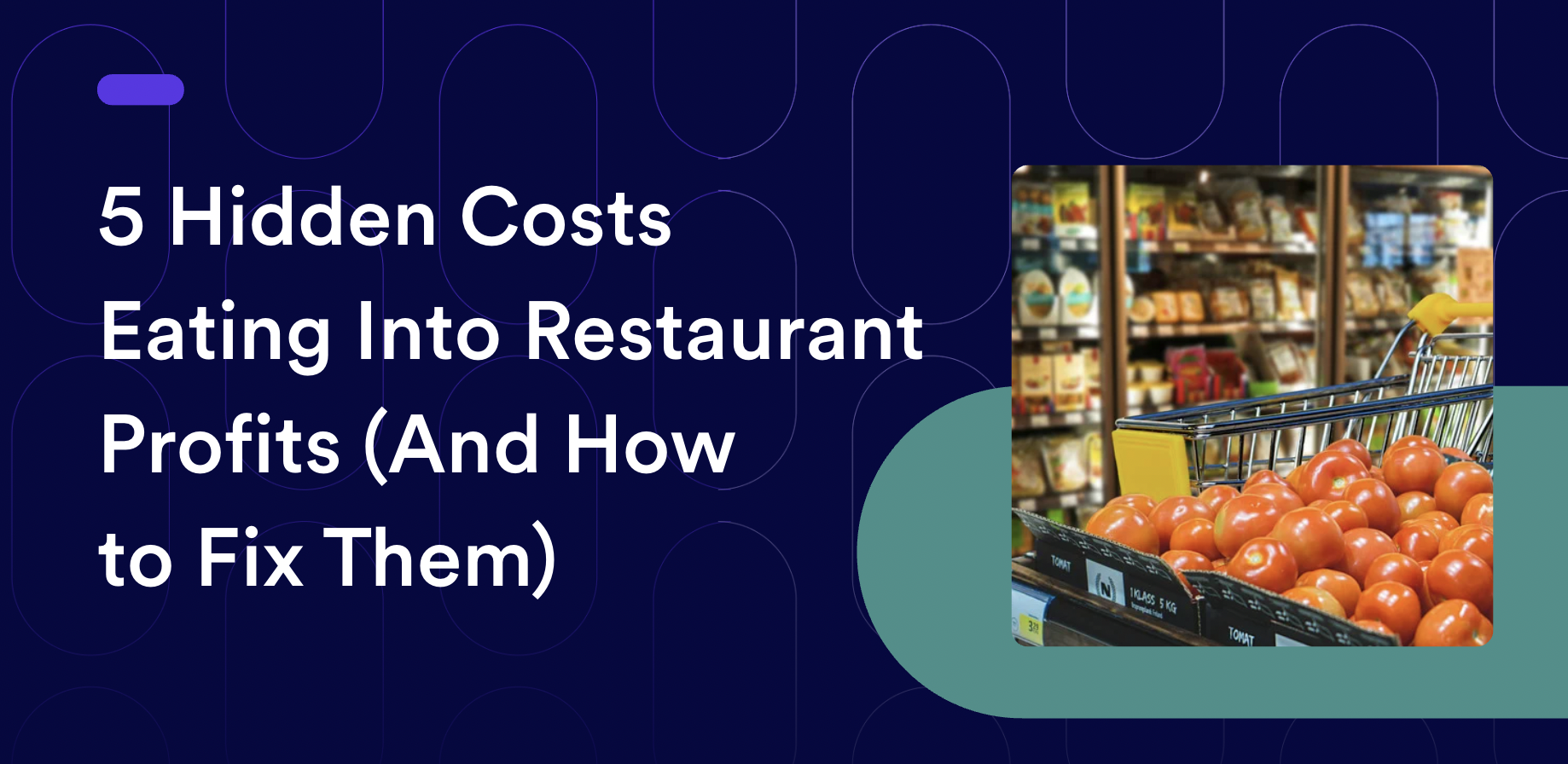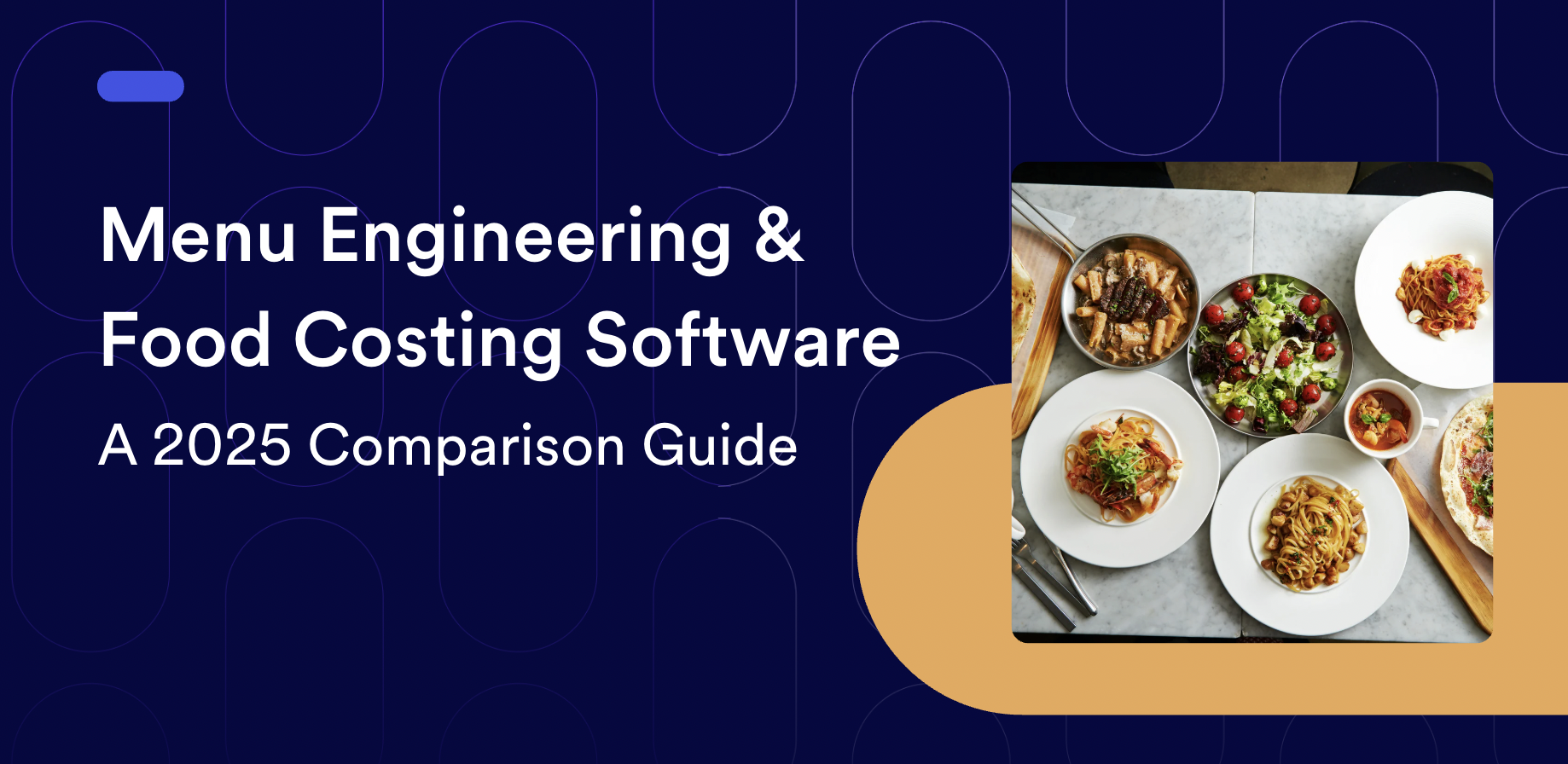For any restaurant, the dynamic between the Front of House (FOH) and Back of House (BOH) teams is crucial for delivering a seamless customer experience.
While each team has distinct roles and responsibilities, their ability to work together is what truly elevates the dining experience, ensuring everything runs smoothly and customers are satisfied.
This blog explores best practices for managing both FOH and BOH teams, strategies to improve communication and efficiency, and ways to create a collaborative culture that drives success.
Understanding FOH and BOH: Key Roles and Responsibilities
The FOH is where the customer experience begins. It's all about creating an inviting atmosphere, providing excellent service, and ensuring guest satisfaction. Key roles in FOH include:
- Host/Hostess: Sets the tone for the guest experience with a warm greeting and efficient seating.
- Waitstaff: Acts as the liaison between guests and the kitchen, ensuring orders are taken accurately and food is served timely.
- Bartenders: Enhance the atmosphere, serve drinks, and often handle customer interactions at the bar.
- Food Runners: Ensure timely and accurate delivery of food from the kitchen to the dining area.
- Bussers: Help maintain a clean dining area and assist in seating turnover.
In contrast, BOH is responsible for food preparation, cooking, and maintaining kitchen operations. Key roles in BOH include:
- Chefs and Line Cooks: Prepare, cook, and plate food with attention to detail and speed.
- Sous Chefs: Assist in managing the kitchen, ensuring staff efficiency and quality control.
- Expeditors: Coordinate the flow of orders from the kitchen to the FOH.
- Dishwashers: Keep the kitchen stocked with clean dishes, ensuring an uninterrupted cooking process.
Best Practices for Managing the Back of House
The efficiency of your BOH is directly linked to kitchen operations, food quality, and timely service. Here are key practices to optimize BOH management:
- Optimize Kitchen Layout: A well-organized kitchen layout minimizes unnecessary movement, reduces prep time, and ensures staff can focus on cooking. Group stations by tasks to ensure smooth workflow.
- Regular Training: Invest in training your kitchen staff on cooking techniques, safety protocols, and inventory management. Consistent training ensures quality and efficiency, even during peak hours.
- Cross-Training: Cross-train your team members to prevent burnout and ensure flexibility. When one person calls out, others can fill in seamlessly without interrupting the kitchen flow.
- Streamlined Inventory Management: Use technology to monitor ingredient levels in real-time, predict stock needs, and reduce food waste by ordering only what's necessary.
- Cultivate a Positive Kitchen Culture: Foster an environment of teamwork and respect in the kitchen. A strong culture encourages feedback, which ultimately improves performance and morale.
Best Practices for Managing the Front of House
The Front of House (FOH) is the face of your restaurant, where first impressions are made and customer experiences are shaped. Effective FOH management ensures smooth operations, satisfied guests, and a motivated team. Here are some best practices to help you manage your FOH like a pro:
- Create a Welcoming Atmosphere: Greet guests promptly with warmth and enthusiasm. Personalize greetings when possible, and ensure guests are seated quickly to set a positive tone for their experience.
- Train for Efficiency and Consistency: Train FOH staff on the menu, etiquette, upselling, and handling customer issues. Continuous training helps maintain high standards and prepares staff for busy shifts.
- Focus on Customer Experience: Ensure attentive, friendly service throughout the dining experience. Check-in with guests, anticipate their needs, and address concerns quickly with empathy.
- Implement a Seamless Seating and Reservation System: Use an efficient system to manage wait times, optimize seating, and handle bookings. Ensure the FOH team can manage reservations and walk-ins smoothly.
- Encourage Team Morale and Motivation: Foster a positive work environment by recognizing hard work, offering growth opportunities, and rewarding excellent performance to keep morale high.
Communication Between FOH and BOH
Communication breakdowns between FOH and BOH can cause delays, frustration, and, ultimately, unhappy customers. Here’s how to improve collaboration:
- Centralize Information: Implement regular briefings to keep both teams updated on menu changes, special requests, and guest feedback. Clear communication protocols help prevent misunderstandings.
- Adapt Your Communication Styles: Avoid a "one-size-fits-all" approach to leadership. Understand the different ways your team members learn, work, and express their challenges. By doing so, you'll foster better understanding and performance.
- Lead with Inspiration, Not Fear The traditional model of screaming at employees in high-pressure environments does not foster learning, improvement, or loyalty. Inspire your team through positive reinforcement, patience, and understanding. Give them space to contribute, and they’ll be more loyal and motivated.
- Empower People to Contribute: Everyone has something valuable to contribute, and it's crucial for leaders to create an environment where people feel comfortable sharing their thoughts and ideas. Encourage open communication and create a platform for people to voice their opinions. Recognize that each person, regardless of their role, can add something meaningful to the team.
- Balance Leadership with Flexibility: A strong leader must stay true to their vision while also being willing to adapt based on circumstances and the needs of the team. Be open to change and learn from experiences. While you should have a clear vision for your business, flexibility in how you achieve it can lead to more innovation and success.
- Understand and Harness Anger Constructively: Anger is a natural reaction, especially when things go wrong. However, a great leader knows how to channel that anger into constructive feedback and teaching moments. Instead of reacting impulsively with frustration or anger, use those moments to pause, reflect, and then guide your team through the issue calmly and productively.
5 Ways to Prevent FOH and BOH Conflicts
Conflict in the restaurant industry is inevitable, especially in the high-pressure environments of Front of House (FOH) and Back of House (BOH).
However, managing these conflicts effectively can elevate operations and improve overall team dynamics. The key to reducing tension and building a strong, collaborative culture is fostering mutual respect and understanding between the two teams.
Here’s how you can prevent and resolve conflicts while strengthening teamwork between FOH and BOH:
1. Job-Swapping and Cross-Department Shadowing
One of the most impactful ways to build empathy between FOH and BOH is through job-swapping and cross-department shadowing. Having FOH staff spend time in the kitchen, and vice versa, allows each team to better understand the pressures and challenges the other faces.
This creates a deeper appreciation for each other's roles and can significantly reduce friction, especially during busy shifts. During onboarding, incorporating job-shadowing as a part of team-building activities helps new hires realize they are part of an interconnected system, setting the tone for cooperation from day one.
2. Cross-Department Training on Communication and Conflict Resolution
Regular training on effective communication, teamwork, and conflict resolution can help prevent issues before they arise. Training should emphasize how both teams contribute to the overall success of the restaurant and how to address potential conflicts constructively.
When everyone is equipped with the tools to communicate openly and resolve conflicts respectfully, it creates a supportive environment that fosters collaboration rather than competition.
3. Fostering a Culture of Respect
A culture of mutual respect is essential for a smooth operation. Encourage open communication where both FOH and BOH teams understand each other’s pressures.
Emphasizing respect during busy times, when stress is high, helps maintain a professional atmosphere. When employees feel respected, they are more likely to collaborate, rather than contribute to tension or conflict.
4. Organizing Team-Building Activities
Team-building activities are a fun and effective way to break down barriers between FOH and BOH. Post-shift outings, team meals, or even offsite events can build camaraderie and alleviate workplace stress.
When teams spend time together outside of service hours, it fosters stronger interpersonal connections, which can lead to better teamwork and smoother operations on the floor.
5. Tip Sharing Programs
A well-structured tip-sharing program can align the goals of both FOH and BOH teams by incentivizing cooperation. When both teams work toward delivering an exceptional dining experience, the shared financial reward encourages mutual success.
Tip-sharing not only aligns the team’s objectives but also reinforces the idea that both FOH and BOH contribute equally to the restaurant's success.
Effective FOH Staff Training & Development
Investing in the training and development of FOH staff ensures that they have the necessary tools to succeed, handle customer interactions, and support a positive restaurant atmosphere.
- Onboarding: Introduce new hires to the restaurant's culture, expectations, and the importance of working collaboratively with the BOH team. Clear onboarding that integrates restaurant values with operational expectations creates a solid foundation for new employees.
- Ongoing Training: Don’t let training end after the first week. Continuous education about product knowledge, customer service techniques, and conflict resolution should be encouraged. Regularly scheduled training sessions help FOH staff stay sharp and motivated.
- Role-Playing & Scenario Training: Preparing staff for difficult customer situations through role-playing can improve service delivery. Scenarios like handling complaints or managing large parties can help staff feel more confident in real-world situations.
- Incentives for Top Performers: Recognizing and rewarding top performers is crucial for maintaining morale and motivating staff. Incentives can include monetary bonuses, gift certificates, or recognition at team meetings, all of which help reinforce a culture of excellence.
- Recognize Different Paths to Success: Not everyone wants to be in a leadership role, but that doesn’t mean they aren’t valuable or capable of contributing to the team in meaningful ways. Recognize and honor the diverse aspirations of your team members. Some may excel in specific tasks and prefer not to take on leadership roles. Empower them to excel in their area of expertise.
Measuring FOH & BOH Success
Tracking performance allows restaurant managers to assess the success of both teams and identify areas for improvement. Key metrics can highlight operational strengths and weaknesses.
- Performance Metrics: Some essential metrics for FOH and BOH success include table turnover rate, customer wait times, sales trends, and customer satisfaction scores. Tracking these metrics can help managers identify when adjustments need to be made and ensure that both teams are working efficiently.
- Staff Retention: High turnover rates can signal dissatisfaction or burnout. Monitoring retention helps managers understand the effectiveness of training, work conditions, and employee engagement, which are key to maintaining consistency in service.
- Customer Feedback: Collecting customer feedback via surveys or comment cards provides insights into areas where both FOH and BOH teams are excelling and where they need improvement. Using feedback to fine-tune operations ensures that the restaurant stays in tune with customer expectations.
Creating a Positive Work Environment for FOH & BOH
The foundation of successful teamwork lies in the work environment. A positive culture encourages collaboration, respect, and productivity, while also reducing stress and turnover.
- Team Engagement: Encourage positive attitudes by recognizing employees' hard work and providing regular feedback. Acknowledging achievements—both big and small—helps keep morale high and reinforces the value of teamwork.
- Workplace Wellness: The physical and mental well-being of your staff should be a priority. Ensure that employees have access to wellness programs, mental health support, and opportunities for physical activity. A healthy staff is a more productive and engaged team.
- Build Long-Term Relationships: Successful leadership is about building relationships and loyalty over time, not just about getting immediate results. Invest in your team's growth and well-being. When people feel supported and valued, they are more likely to stay long-term, increasing your team’s stability and productivity.
- Value Every Role and Contribution: Everyone has a role, and it's important to appreciate the value each person brings, even if they aren't in a leadership position. Recognize and reward the contributions of all team members, not just those in leadership or visible roles. A great team thrives when everyone feels valued and important.
How meez Can Enhance FOH & BOH Operations
meez is an essential tool for improving both Front of House (FOH) and Back of House (BOH) operations. By centralizing recipe management, streamlining communication, and providing real-time data, meez allows for greater efficiency and smoother coordination between the two teams. Here's how meez can support key areas of FOH & BOH success:
- Allergen & Intolerance Identification: FOH staff can use meez to quickly identify allergens or food intolerances in recipes, making it easier to answer customer questions without needing to interrupt the kitchen. With a simple filter, recipes can be filtered out based on dietary restrictions, allowing the FOH to confidently recommend dishes to guests with specific needs.
- Centralized Recipe Updates: When a new menu item is introduced, meez automatically notifies both FOH and BOH teams, ensuring that everyone is on the same page. The platform provides detailed menu item descriptions, ingredients, preparation methods, and photos or videos, so FOH staff can clearly explain dishes to guests without confusion. This also ensures that any changes to recipes are instantly shared, preventing miscommunication.
- Efficient Inventory Management: meez helps streamline inventory checks by allowing teams to track ingredients that make up the majority of food costs. This enables more accurate inventory counts, reducing waste, and ensuring the kitchen has the supplies they need for smooth operations. Managers can also track the performance of ingredients to better understand which menu items are profitable and which may need to be adjusted.
- Accurate Scaling for Catering: For catering events or large orders, meez makes it easy to scale recipes accurately, helping reduce waste and ensuring consistency. Both FOH and BOH can be aligned on recipe quantities and ingredient amounts, reducing the chance of errors and providing a smoother catering experience.
- Menu Performance Analysis: meez allows managers to analyze menu item performance data, offering insights into which dishes are performing well and which might need adjustments. This data helps both FOH and BOH teams make informed decisions about menu offerings, pricing, and inventory management.
By incorporating meez into your restaurant's operations, you can enhance communication between FOH and BOH, reduce inefficiencies, and create a more cohesive team. The platform’s ability to centralize recipe information, streamline menu updates, and improve inventory management empowers both teams to focus on what matters most: providing an exceptional guest experience.
Conclusion: The Key to Restaurant Success
A well-managed relationship between FOH and BOH teams is the key to ensuring operational success, customer satisfaction, and long-term profitability.
By implementing effective onboarding, training, and communication practices, and leveraging technology, restaurant managers can create a smooth, collaborative environment where both teams work together to deliver the best possible experience for guests.
Investing in your team, fostering teamwork, and utilizing the right tools will pay off by helping your restaurant thrive.











